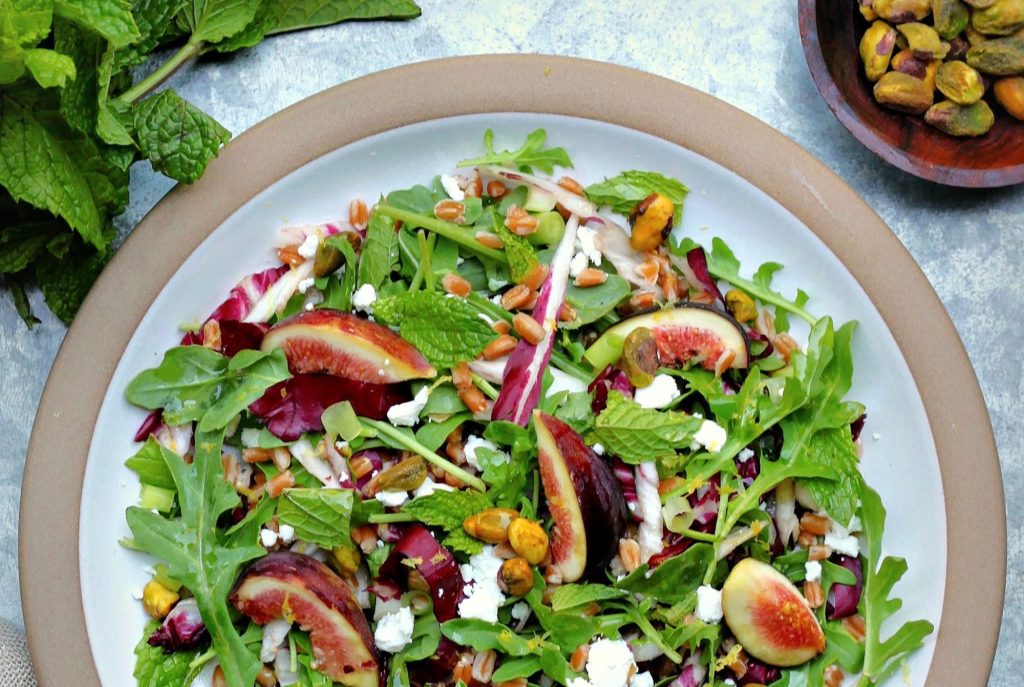
By Lynda Balslev | TasteFood
As the season for fresh produce reaches its peak, figs emerge as a standout fruit, celebrated for their luscious and delicate nature. These fruits, with their varied and nuanced flavors, offer a unique taste experience depending on their type. For example, the small Black Mission figs are known for their dark, sweet, and jammy flavor, complemented by tiny seeds that provide a slightly grainy texture. Meanwhile, the plump Calimyrna figs, large and golden-green, offer a mildly sweet, nutty, and vegetal flavor. Brown Turkey figs, with their streaks of purple and yellow and soft pink interior, strike a middle ground with a mild, honeyed flavor, making them versatile for both sweet and savory dishes.
While it’s easy to enjoy ripe figs straight from the market, their culinary potential extends far beyond. Those fortunate enough to have an abundance of figs can experiment by adding them to salads, layering them into sandwiches, or using them as a topping for pizzas and bruschetta. One such recipe that highlights the versatility of figs is a Fig, Arugula, and Farro Salad, which combines the nutty grain with the sweetness of figs and the creaminess of goat cheese.
Exploring the Versatility of Figs in Culinary Creations
The culinary world has long embraced figs for their adaptability and rich flavors. According to culinary experts, figs can transform a dish from ordinary to extraordinary with their unique taste and texture. Chef Maria Lopez, a renowned culinary expert, notes, “Figs are a chef’s dream ingredient. They can be used in both sweet and savory dishes, adding depth and complexity.”
Historically, figs have been a staple in Mediterranean diets, valued not only for their flavor but also for their nutritional benefits. Rich in fiber, vitamins, and minerals, figs have been associated with numerous health benefits, including improved digestion and heart health.
A Deeper Dive into Fig Varieties
Understanding the different types of figs can enhance the culinary experience. Black Mission figs, for example, are often used in desserts and jams due to their intense sweetness. In contrast, Calimyrna figs are preferred for cheese platters and salads, where their subtle flavor can shine without overpowering other ingredients. Brown Turkey figs, with their balanced flavor, are ideal for baking and cooking, providing a gentle sweetness that complements a variety of dishes.
Recipe Spotlight: Fig, Arugula, and Farro Salad
This salad is a perfect example of how figs can elevate a dish. Combining the nutty flavor of farro with the peppery bite of arugula and the creamy tang of goat cheese, this salad is both satisfying and nutritious. The addition of pistachios and fresh mint adds a delightful crunch and freshness, while a simple dressing ties all the flavors together.
Fig, Arugula, and Farro Salad Recipe:
- Active Time: 10 minutes
- Total Time: 40 minutes, plus cooling time
- Yield: Serves 4
Ingredients:
- 1/2 cup semi-pearled farro
- 1 1/2 cups water
- 2 tablespoons white balsamic vinegar
- 1 tablespoon fresh lemon juice
- 1 teaspoon runny honey
- 1 teaspoon Dijon mustard
- 1/4 teaspoon kosher salt, or more to taste
- 1/8 teaspoon freshly ground black pepper
- 1/3 cup extra-virgin olive oil
- 3 ounces fresh baby arugula
- 1/2 small head radicchio, shredded (optional)
- 5 to 6 plump Brown Turkey figs, stemmed and quartered
- 2 ounces fresh goat cheese, crumbled
- 2 to 3 tablespoons torn fresh mint leaves
- 2 tablespoons coarsely chopped unsalted pistachios
- Finely grated lemon zest, for garnish
Instructions:
Combine the farro and water in a large saucepan and bring to a boil. Reduce the heat to medium-low, partially cover the pot, and simmer until the farro is tender, about 30 minutes. Drain the farro in a fine-mesh sieve and transfer to a bowl. Cool to room temperature.
Make the dressing: Combine the vinegar, lemon juice, honey, mustard, salt, and pepper in a small bowl. Add the oil in a steady stream, whisking to emulsify.
Assemble the salad: Combine the arugula and radicchio in a large, wide serving bowl. Scatter the farro over the salad and top with the figs, cheese, and mint. Drizzle some of the dressing and gently toss to combine. Add more dressing to your taste. Garnish with the pistachios and lemon zest.
The Future of Fig Cultivation and Consumption
As the demand for figs continues to grow, agricultural experts are exploring sustainable cultivation methods to ensure a steady supply. According to the California Fig Advisory Board, the state produces nearly 98% of the figs grown in the United States, highlighting the importance of sustainable practices in this region.
Looking ahead, the versatility and health benefits of figs are expected to drive their popularity even further, with chefs and home cooks alike finding new and exciting ways to incorporate them into their culinary creations.
Lynda Balslev is an award-winning writer, cookbook author, and recipe developer based in northern California. Visit TasteFood at TasteFoodblog.com.







